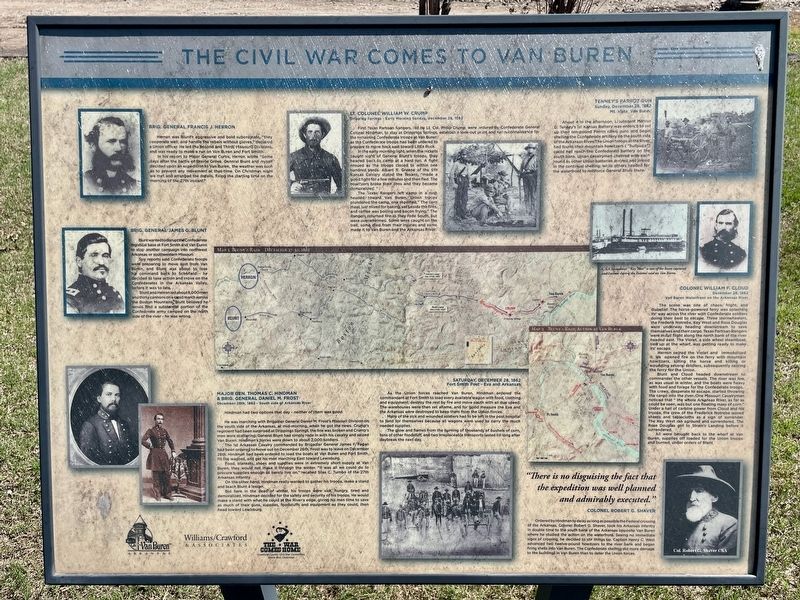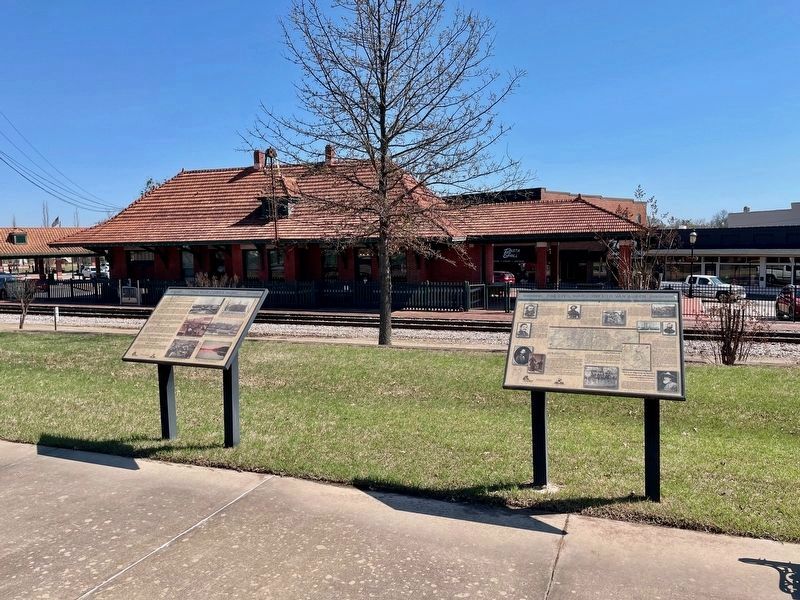Van Buren in Crawford County, Arkansas — The American South (West South Central)
The Civil War Comes to Van Buren
Brig. General Francis J. Herron
Herron was Blunt's aggressive and bold subordinate, "they cooperate well, and handle the rebels without gloves," declared a Union officer. He led the Second and Third (Missouri) Divisions, and was ready to make a run on Van Buren and Fort Smiith [sic].
In his report to Major General Curtis, Herron wrote "Some days after the battle of Prairie Grove, General Blunt and myself decided upon an expedition to Van Buren, the weather was such as to prevent any movement at that time. On Christmas night we met and arranged the details, fixing the starting time on the morning of the 27th instant."
Brig. General James G. Blunt
Blunt wanted to disrupt the Confederate logistical base at Fort Smith and Van Buren to stop another campaign into northwest Arkansas or southwestern Missouri.
Spy reports said Confederate troops were preparing to move east from Van Buren, and Blunt was about to lose his command back to Schofield he decided to take action and move on the Confederates in the Arkansas Valley, before it was to late.
Blunt and Herron led about 8,000 men and thirty cannons on a rapid march across the Boston Mountains, Blunt believed he would find a substantial portion of the Confederate army camped on the north side of the river - he was wrong.
Major Gen. Thomas C. Hindman
& Brig. General Daniel M. Frost
December 28th, 1862 - South side of Arkansas River
Hindman had two options that day - neither of them was good. He was marching with Brigadier General Daniel M. Frost's Missouri Division on, the south side of the Arkansas, at mid-morning, when he got the news. Crump's regiment had been surprised at Drippings Springs, the line was broken and Crump's men were scattering. General Blunt had simply rode in with his cavalry and seized Van Buren. Hindman's forces were down to about 2,000 soldiers.
The 1st Arkansas Cavalry commanded by Brigadier General James F Fagan had been ordered to move out on December 26th, Frost was to leave on December 28th. Hindman had been ordered to load the boats at Van Buren and Fort Smith, fill the wagons, and get his men marching East toward Lewisburg.
Food, blankets, shoes and supplies were in extremely short supply at Van Buren, they would not make it through the winter. "It was all we could do to procure supplies enough to barely live on," recalled Silas C. Turnbo of the 27th Arkansas Infantry.
On the other hand, Hindman really wanted to gather his troops, make a stand and teach Blunt a lesson.
But here in the dead of winter, his troops were sick, hungry, tired and demoralized,
Hindman decided for the safety and security of his troops. He would
make a stand with what he could at the River's edge, giving his men time to save
as much of their guns, supplies, foodstuffs and equipment as they could, then
head toward Lewisburg.
Lt. Colonel William W. Crump
Dripping Springs Early Morning Sunday, December 28, 1862
First Texas Partisan Rangers, led by Lt. Col. Philip Crump were ordered by Confederate General Colonel Hindman, to stay at Drippings Springs, establish a look-out point and run reconnaissance for the remaining Confederate troops at Van Buren, as the Confederate troops had been ordered to prepare to move back east toward Little Rock. In the early morning light, when the pickets caught sight of General Blunt's troops, they headed back to camp at a hard run. A fight, ensued as the troops closed to within one hundred yards. Albert R. Greene of the 5th Kansas Calvary stated the Texans, "made a good fight for a few minutes and then fled. The howitzers broke their lines and they became demoralized."
The Texas Rangers left camp in a rush headed toward Van Buren, Union troops plundered the camp, one reported, "The corn meal, just mixed for baking, sat beside the fires, and coffee was boiling and bacon frying." The Rangers returned fire as they rode South, but were overwhelmed. Some were caught on the trail, some died from their injuries and some made it to Van Buren and the Arkansas River.
Saturday, December 28, 1862
Fort Smith Post - Eva and Arkansas
As the Union forces reached Van Buren, Hindman ordered the commandant at Fort Smith to load every available wagon with food, clothing and equipment; destroy the rest by fire and move south with all due speed. The warehouses were then set aflame, and for good measure the Eva and the Arkansas were destroyed to keep them from the Union forces.
Many of the sick and wounded soldiers had to be left in the post hospital to fend for themselves because all wagons were used to carry the much needed supplies.
The glow and flames from the burning of thousands of bushels of corn, tons of other foodstuff, and two irreplaceable transports lasted till long after daybreak the next day.
Tenney's Parrot Gun
Sunday, December 28, 1862
Mt. Vista, Van Buren
About 4 in the afternoon, Lieutenant Marcus D. Tenney's 1st Kansas Battery was ordered to set up their ten-pound Parrot rifled guns and begin shelling the Confederate artillery on the south side of the Arkansas River The Union troops at the River, had found their mountain howitzers ("bullpups") could not reach the Confederate battery on the south bank. Union cavalrymen cheered with each round as other Union batteries arrived and joined in the continual shelling; while others headed for the waterfront to reinforce General Blunt there.
Colonel William F. Cloud
December 28, 1862
Van Buren Waterfront on the Arkansas River
The scene was one of chaos, fright, and disbelief. The horse-powered ferry was splashing its' way across the river with Confederate soldiers doing their best to escape. Three sternwheelers, the Frederik Notrebe, Key West and Rose Douglas were underway heading downstream to save themselves and their cargo. Texas Partisan Rangers were in full flight along the north bank of the river headed east. The Violet, a side wheel steamboat, tied up at the wharf, was getting ready to make its' escape.
Herron seized the Violet and immobilized it. He opened fire on the ferry with mountain howitzers, killing the horse and killing or wounding several soldiers, subsequently seizing the ferry for the Union.
Blunt and Cloud headed downstream to commander the other vessels. The river was low, as was usual in winter, and the boats were heavy with food and forage for the Confederate troops. The crews, desperate to escape, started throwing the cargo into the river. One Missouri Cavalryman noticed that "the whole Arkansas River, as far as could be seen, was but one floating mass of corn." Under a hail of carbine power from Cloud and his troops, the crew of the Frederick Notrebe waved sheets and tablecloths as a sign of surrender. The Key West ran aground and surrendered. The Rose Douglas got to Strain's Landing before it surrendered.
All were brought back to the wharf at Van Buren, supplies off loaded for the Union troops and burned, under orders of Blunt.
"There is no disguising the fact that the expedition was well planned and admirably executed."
Colonel Robert G. Shaver
Ordered by Hindman to delay as long as possible the Federal crossing of the Arkansas, Colonel Robert G. Shaver, took his Arkansas infantry in double time to the south bank of the Arkansas opposite Van Buren where he studied the action on the waterfront. Seeing no immediate signs of crossing, he decided to stir things up. Captain Henry C. West advanced two twelve-pound howitzers to the river bank and began firing shells into Van Buren. The Confederate shelling did more damage to the buildings in Van Buren than to deter the Union forces.
Erected by Williams/Crawford Associates · Crawford County Civil War Committee · Main Street Van Buren.
Topics. This historical marker is listed in this topic list: War, US Civil. A significant historical date for this entry is December 28, 1862.
Location. 35° 26.236′ N, 94° 21.145′ W. Marker is in Van Buren, Arkansas, in Crawford County. Marker is on Fayetteville Road (Arkansas Route 59) south of McKinney Street, on the left when traveling south. Touch for map. Marker is in this post office area: Van Buren AR 72956, United States of America. Touch for directions.
Other nearby markers. At least 8 other markers are within walking distance of this marker. The War Comes Home (here, next to this marker); The Heart of Van Buren (within shouting distance of this marker); The Frisco Depot (within shouting distance of this marker); Veteran's Memorial Plaza (about 300 feet away, measured in a direct line); Four Freedoms (about 400 feet away); The Stars of Freedom ★ ☆ ★ (about 400 feet away); GFWC Women's League Veterans Memorial (about 500 feet away); Camp Jesse Turner (about 500 feet away). Touch for a list and map of all markers in Van Buren.
Related marker. Click here for another marker that is related to this marker. The War Comes Home
Also see . . . The Battle of Van Buren - Van Buren, Arkansas. Winter Battle on the Arkansas (Submitted on March 30, 2024, by Mark Hilton of Montgomery, Alabama.)
Credits. This page was last revised on March 30, 2024. It was originally submitted on March 30, 2024, by Mark Hilton of Montgomery, Alabama. This page has been viewed 45 times since then. Photos: 1, 2. submitted on March 30, 2024, by Mark Hilton of Montgomery, Alabama.

